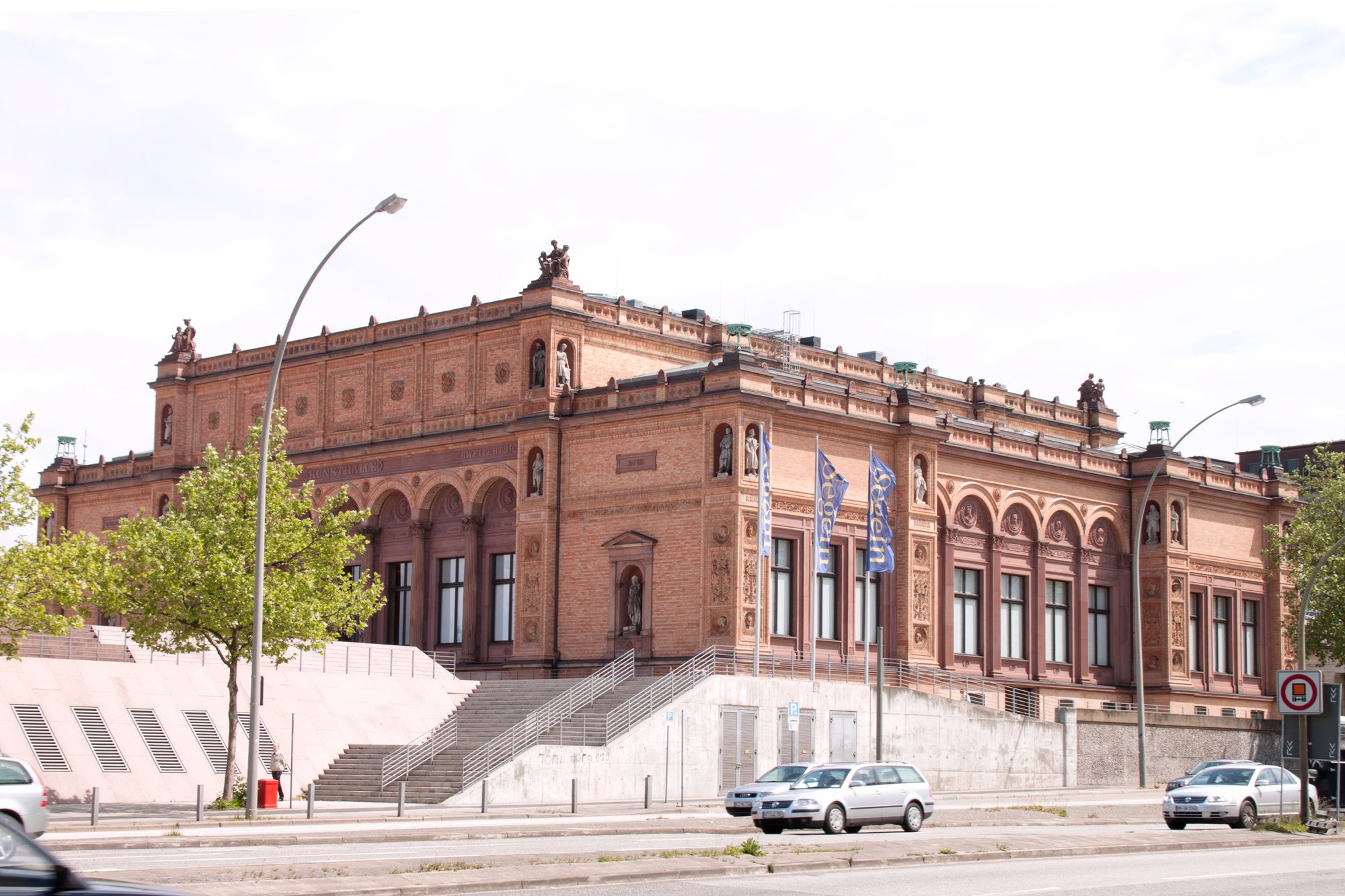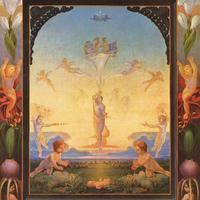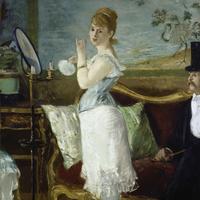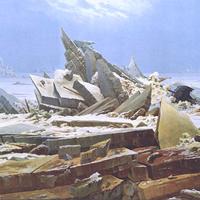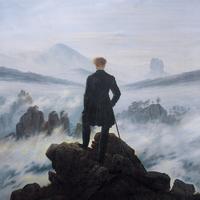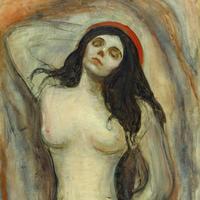More about Hamburger Kunsthalle
Works at Hamburger Kunsthalle

Contributor
This museum is the epitome of German architecture and it takes itself seriously enough to live up to that title.
If you’re hanging around in Hamburg, Germany on a rainy day and have a few hours to kill, the Kunsthalle Hamburg is easy to reach by bus or train; there are stations for both right next to the museum. Kunsthalle Hamburg also has a great cafe overlooking the city of Hamburg, so it’s a nice spot to grab lunch, too.
The Kunsthalle Hamburg is one of Germany’s largest museums (in terms of gallery space, not collection size) and houses works from some of art history’s most famous artists including Rembrandt, Edvard Munch, and Caspar David Frederich. The collection itself is internationally acclaimed, thanks in no small part to the monthly special collections that help add to the experience of the museum’s ever-expanding permanent collection. The contents of the museum basically play out like an art history 101 textbook, spanning seven centuries and including works from ye olde Medieval times, all the way through contemporary artists. Collections are even organized according to era.
Probably the best part about the museum, though, is the architecture. The whole institution is made of three buildings: one made out of brick that is insanely ornamental, the next made out of limestone and done in a neo-classical style, and the last is a uber modern building designed by the architect Oswald Mathais. The museum space is huge and laid out so that it doesn’t get very crowded, even during peak visiting time. But the best part is that all of the buildings are connected by an underground tunnel! So fancy!
Sources
- Dar268, Geeena, Lews31, and DavidTAC. "Hamburger Kunsthalle: Top Tips Before You Go." TripAdvisor. Accessed October 31, 2017. https://www.tripadvisor.com/Attraction_Review-g187331-d243273-Reviews-H….
- "Hamburger Kunsthalle." Hamburg Tourismus. Accessed October 31, 2017. http://www.hamburg-travel.com/hamburger-kunsthalle-1/.
- "Kunsthalle art museum in Hamburg." Hamburg.de. Accessed October 31, 2017. http://www.hamburg.com/museums/kunsthalle/.

Contributor
Spanning three buildings and eight centuries worth of European art, the Kunsthalle Hamburg is the sort of museum you could spend hours delving into and still leave feeling like you’ve barely scratched the surface.
The sweeping selection of art on display is arranged in chronological order, with particularly top-notch collections of art from the 19th and early 20th centuries. For fans of German Romanticism, this museum is an absolute must-see: there’s an entire room devoted to the iconically moody landscapes of Caspar David Friedrich, including such embodiments of the Romantic spirit as his Wanderer Above the Sea of Fog (featuring exactly what I imagine whenever I think of any Romantic poet: some dude in a frock coat standing on a mountaintop like he owns the place) and The Sea of Ice. Also on display are an extensive collection of drawings and paintings by Philipp Otto Runge, fellow founder of German Romanticism, and works by leading German impressionist Max Liebermann. French art of the 19th century is just as well-represented as its German counterpart, including works by Édouard Manet, Claude Monet, Paul Cézanne, and more. And if Modernism is a little more your speed, have no fear—there’s plenty for you, too. Just trot on down to the Gallery of Modern Art to check out gems like Madonna by Edvard Munch, displayed alongside important artworks by Lovis Corinth, Max Beckmann, Paul Klee, and the Surrealists.
Largely to thank for this portion of the collection is Alfred Lichtwark, first director of the Kunsthalle Hamburg, pioneer in the field of museum education, and all-around pretty interesting guy. Upon his arrival in Hamburg in 1886, he was appalled by what he saw as a disgraceful lack of appreciation for culture in its citizens (which seems a bit harsh, if you ask me), and made it his life’s mission to breathe a little bit of new life into Hamburg’s then-dead art scene. A passionate advocate for educational reform, he believed that Hamburg’s artistic poverty stemmed directly from the inadequate schooling of its children. In his view, the German school system suffered from an over-reliance on rote memorization, resulting, he argued, in a population sorely ill-equipped to produce fresh new artistic works of their own. His proposed solution was to reorient German education away from rote memorization into a more participatory model, as well as to promote dilettantism in the arts among the well-to-do. By creating their own art, Lichtwark believed, the people of Hamburg would feel more intimately connected with what they saw adorning the halls of museums.
To promote his new educational vision, Lichtwark shocked the public by displaying the works of dilettantes alongside the works of old masters like Lucas Cranach the Elder, Giovanni Battista Tiepolo, Rembrandt, Anthony van Dyck, and others. He also had the bright idea to bring in then-contemporary artists from all over Europe—among them Max Liebermann, Pierre Bonnard, and Édouard Vuillard—to create paintings specifically for the Kunsthalle Hamburg (where they remain to this day) in an attempt to grow Hamburg’s reputation as a flourishing city for the arts. To commemorate the 100th anniversary of Lichtwark’s death, the museum had the idea to revive this concept in 2014, bringing in six contemporary artists from around the world to create Hamburg-themed works of art designed specifically for the Kunsthalle Hamburg. In fact, the Kunsthalle Hamburg remains committed to Lichtwark’s educational mission in more ways than one: they also use the money raised by membership fees to provide art classes for children attending schools in socially deprived areas, as well as to fund internships in museum education. A membership gets you free admission to the museum, discounted classes, invites to exhibition openings, and more, which, when you add in the satisfaction of knowing your money has gone toward a good cause, seems like a pretty sweet deal to me.
Surely Lichtwark, a great supporter of the contemporary artists of his day, would also approve of the Kunsthalle Hamburg’s latest addition: the Gallery of Contemporary Art, called simply “The Cube” (and yes, it’s exactly what it sounds like). Accessible through a super cool underground tunnel, the starkly white, minimalist building is home to works by such artists as Gerhard Richter, Jenny Holzer, Richard Serra, and more.
This huge selection of buildings to visit and swathes of history to learn about might sound a bit daunting (I have to admit, it does to me...I can feel the museum fatigue coming on already), but don’t worry! The Kunsthalle Hamburg offers an in-depth tour of European art history from the Middle Ages to the present to help make sense of it all, one of the few of its kind in all of Europe. Hamburg’s art scene has also come a long way since Lichtwark’s appointment—there’s a huge selection of great museums to visit in Hamburg, including four within walking distance of the Kunsthalle Hamburg: the Museum of Arts and Crafts (MKG), the Deichtorhallen, the Bucerius Kunstforum, and the Kunstverein. All are accessible with a single ticket called the Kunstmeile Pass, which gives you access to five museums for the price of three—perfect for the insatiable museumgoer who, even after browsing everything the Kunsthalle Hamburg has to offer, still wants more.
Sources
- “About the Collection.” Hamburger Kunsthalle. Accessed May 23, 2020. https://www. hamburger- kunsthalle.de/en/about-collection.
- “Become a Member.” Hamburger Kunsthalle. Accessed May 23, 2020. https://www.hamburger- kunsthalle.de/en/become-member.
- “Become a Member.” Malschule in der Kunsthalle. Accessed May 24, 2020. https://www. malschulverein.de/html/mitgliedschaft.html.
- “Contemporary Art.” Hamburger Kunsthalle. Accessed May 23, 2020. https://www.hamburger- kunsthalle.de/en/contemporary-art.
- “Eight Centuries of Art.” Hamburger Kunsthalle. Accessed May 21, 2020. https:// www.hamburger-kunsthalle.de/en/exhibitions/eight-centuries-art.
- Fishman, Sterling. “Alfred Lichtwark and the Founding of the German Art Education Movement.” History of Education Quarterly 6, no. 3 (1966): 3-17.
- “Hamburger Kunsthalle.” Lonely Planet. Accessed May 22, 2020. https://www.lonelyplanet. com/germany/hamburg/attractions/hamburger-kunsthalle/a/poi-sig/1270318/359370
- “Kunsthalle.” Hamburg.com. Accessed May 22, 2020. https://www.hamburg.com/museums/ 11750424/kunsthalle/.
- “Kunstmeile.” Hamburg.com. Accessed May 24, 2020. https://www.hamburg.com/museums/ 12781552/kunstmeile/.
- “Lichtwark Revisited: Artists’ Views of Hamburg.” Hamburger Kunsthalle. Accessed May 20, 2020. https://www.hamburger-kunsthalle.de/en/exhibitions/lichtwark-revisited.
- “Modern Art.” Hamburger Kunsthalle. Accessed May 22, 2020. https://www.hamburger- kunsthalle.de/en/modern-art.
- “Nineteenth Century.” Hamburger Kunsthalle. Accessed May 22, 2020. https://www.hamburger- kunsthalle.de/en/nineteenth-century.
- “Old Masters.” Hamburger Kunsthalle. Accessed May 23, 2020. https://www.hamburger- kunsthalle.de/en/old-masters.
Featured Content
Here is what Wikipedia says about Hamburger Kunsthalle
The Hamburger Kunsthalle is the art museum of the Free and Hanseatic City of Hamburg, Germany. It is one of the largest art museums in the country. It consists of three connected buildings, dating from 1869 (main building), 1921 (Kuppelsaal) and 1997 (Galerie der Gegenwart), located in the Altstadt district between the Hauptbahnhof (central train station) and the two Alster lakes.
The name Kunsthalle indicates the museum's history as an 'art hall' when it was founded in 1850. Today, it houses one of the few art collections in Germany that cover seven centuries of European art, from the Middle Ages to the present day. Its permanent collections focus on North German painting of the 14th century, paintings by Dutch, Flemish and Italian artists of the 16th and 17th centuries, French and German drawings and paintings of the 19th century, and international modern and contemporary art.
Check out the full Wikipedia article about Hamburger Kunsthalle

